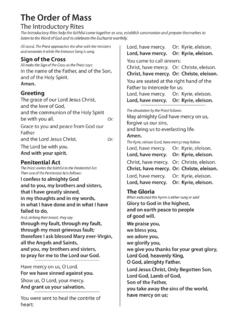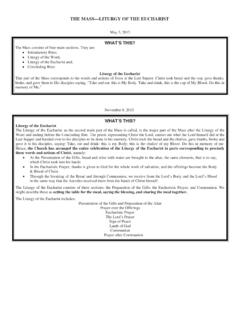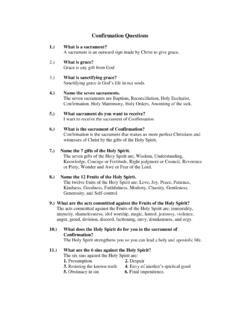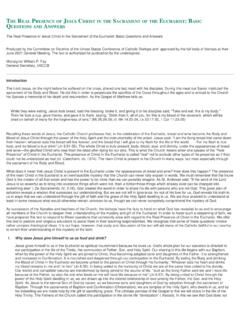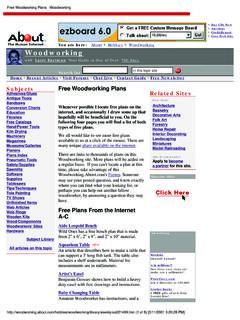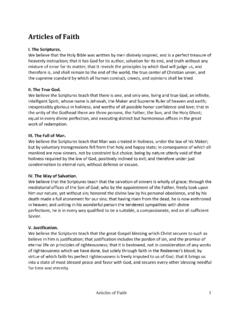Transcription of A Walk Through the Mass: A Step-by-Step Explanation
1 A Walk Through the mass : A Step-by-Step Explanation Catholics know what is going to happen next. One of the basic, distinctive marks of our way of praying is ritual: We do things over and over. When the priest says, The Lord be with you, without any thought or hesitation the congregation responds, And with your Spirit. The priest says, Let us pray, and the congregation stands up. Our daily lives have their rituals also: There are set ways of greeting people, eating, responding to a text. And when we are accustomed to a certain way of doing things we seldom ask why we do it that way. In the Eucharist, too, we have many ritual actions which we perform without asking why. What is the mass or Liturgy? A good way to describe the mass is to say that it is Holy Thursday, Good Friday and Easter Sunday made present today in ritual. It is not merely a meal which reminds us of the Last Supper, or a Passion play which helps recall Good Friday, or a Sunrise Service which celebrates the Lord s Resurrection.
2 The basic shape of the ritual of the mass can be described as a meal. This is not to say it is just another meal or that we are ignoring the mass as sacrifice. Not at all. The point is, the shape of the mass , even when viewed as sacrifice, is that of a meal. When friends gather for a meal, they sit and talk: Eventually they move to the table, say grace, pass the food and eat and drink, and finally take their leave and go home. On our walk Through the mass we will follow this same map: we will see ritual acts of 1) gathering, 2) storytelling, 3) meal sharing and 4) commissioning. Part one: Gathering rites Coming together, assembling, is at the heart of our Sunday worship. The reason behind each of the ritual actions of the first part of the mass can be found in this word: gathering. The purpose of these rites is to bring us together into one body, ready to listen and to break bread together. Greeters. In many churches today there will be someone at the door to greet you as you arrive for Sunday mass : We all like to be greeted and welcomed when we gather for a celebration.
3 When friends come for a meal or a party, we greet them at the door and welcome them into our home. Use of water. One of the first things Catholics do when they come to church is dip their right hand in water and make the sign of the cross. This ritual is a reminder of our Baptism: We were baptized with water and signed with the cross. At every mass we renew our promises to die to sin. Genuflection. In medieval Europe, it was a custom to go down on one knee (to genuflect) before a king or person of rank. This secular mark of honor gradually entered the Church and people began to genuflect to honor the altar and the presence of Christ in the tabernacle before entering the pew. Today many people express their reverence with an even older custom and bow to the altar before taking their place. Posture, song. When the mass begins everyone stands up. Standing is the traditional posture of the Christian at prayer: It expresses our attentiveness to the word of God and our readiness to carry it out.
4 Often we begin by singing together. What better way to gather than to unite our thoughts and our voices in common word, rhythm and melody. (all the parts of music, harmony, melody, different instruments-separate they are not complete) Greeting. The priest will ask us to begin with the sign of the cross, again reminding us of Baptism, and will greet us, saying, The Lord be with you. You will hear this greeting frequently. It means many things. Like good day it can mean A Walk Through the mass : A Step-by-Step Explanation both hello and good-bye. It is both a wish (may the Lord be with you) and a profound statement of faith (as you assemble for worship, the Lord is with you). It is an ancient biblical greeting: Boaz returned from Bethlehem (we read in the Book of Ruth 2:4) and said to the reapers, The Lord be with you! The ritual response to this greeting is always the formula, And with your spirit, by which we return the hello, the good wishes, the statement of faith.
5 Penitential Rite, Gloria. All the other ritual acts of this first part of the mass are intended to gather us together into a worshiping assembly. Sometimes we are asked to pause and recall our common need for salvation (the Penitential Rite). Sometimes the hymn Glory to God in the Highest is sung or recited at this point. The Gloria has been a part of the mass since about the sixth century! These longer hymns and responses are found in the missalette at our seat. Opening Prayer. At the close of this first part of the mass the priest will ask us to join our minds in prayer, and after a few moments of silence he will collect our intentions into one prayer to which we all respond Amen, a Hebrew word for So be it. Part two: Story telling Liturgy of the Word. When we gather at a friend s home for a meal, we always begin with conversation, telling our stories. At mass , after the rites of gathering, we sit down and listen as readings from the Word of God are proclaimed.
6 They are the stories of God s people. Three readings and a psalm. On Sundays there are three readings from the Bible. The first reading will be from the Hebrew Scriptures. (except during the Easter season) We recall the origins of our covenant. It will relate to the Gospel selection and will give background and an insight into the meaning of what Jesus will do in the Gospel. Then we will sing or recite a psalm a song from God s own inspired hymnal, the Book of Psalms of the Hebrew Bible. The second reading will usually be from one of the letters of Paul or another apostolic writing. The third reading will be taken from one of the four Gospels. Some visitors to the Catholic mass are surprised to find us reading from the Bible! We have not generally been famous for our Bible reading, and yet the mass has always been basically and fundamentally biblical. Even some Catholics might be surprised to learn how much of the mass is taken from the Bible: Not only the three readings and the psalm, not only the obviously biblical prayers such as the Holy, Holy, Holy and the Lord s Prayer, but most of the words and phrases of the prayers of the mass are taken from the Bible.
7 Standing for the Gospel. Because of the unique presence of Christ in the proclamation of the Gospel, it has long been the custom to stand in attentive reverence to hear these words. We believe that Christ is present in his word, since it is he himself who speaks when the holy Scriptures are read in the church (Constitution on the Sacred Liturgy, #7). The priest will again greet us with The Lord be with you. He then introduces the Gospel reading while marking a small cross on his forehead, lips and heart with his thumb while praying silently that God cleans his mind and his heart so that his lips may worthily proclaim the Gospel. In many places, the congregation performs this ritual action along with the priest. The Gospel reading concludes with the ritual formula The Gospel of the Lord and we respond, Praise to you, Lord Jesus Christ, again proclaiming our faith in the presence of Christ in the word. Then we sit for the homily.
8 Homily. It means more than just a sermon or a talk about how we are to live or what we are to believe. It is an act of worship rooted in the texts of the mass and especially in the readings from Scripture which have just been proclaimed. The homily takes that word and brings it to our life situation today. Just as a large piece of bread is broken to feed individual persons, the word of God must be broken open so it can be received and digested by the congregation. A Walk Through the mass : A Step-by-Step Explanation Creed. Now we stand and together recite the creed. The creed is more than a list of things which we believe. It is a statement of our faith in the word we have heard proclaimed in the Scripture and the homily, and a profession of the faith that leads us to give our lives for one another as Christ gave his life for us. Universal Prayer. The Liturgy of the Word (our storytelling part of the mass ) comes to an end with the intercessions.
9 The intercessions help us become who God is calling us to be. We are the Body of Christ by Baptism. Now, as we prepare to approach the table for Eucharist, we look into the readings, like a mirror, and ask: Is that who we are? Does the Body of Christ present in this assembly resemble that Body of Christ pictured in the Scripture readings? Usually not! And so we make some adjustments; we pray that our assembly really comes to look like the Body of Christ, a body at peace, with shelter for the homeless, healing for the sick, food for the hungry. We pray for the Church, nations and their leaders, people in special need and the local needs of our parish the petitions usually fall into these four categories. A minister will announce the petitions, and we are usually given an opportunity to pray for the intentions in our heart, making some common response aloud like, Lord, hear our prayer. Part three: Meal sharing After the readings, we move to the table.
10 As at a meal in the home of a friend, we 1) set the table, 2) say grace and 3) share the food (we eat and drink). At mass these ritual actions are called 1) the Preparation of the Gifts, 2) the Eucharistic Prayer, 3) the Communion Rite. Preparation of the Gifts The early Christians each brought some bread and wine from their homes to the church to be used for the mass and to be given to the clergy and the poor. Today a similar offering for the parish and the poor is made with our monetary contributions. Members of the parish will take up a collection from the assembly and bring it to the priest at the altar with the bread and wine to be used for the sacrifice. The priest places the bread and wine on the table. He then mixes water with the wine and washes his hands to help us think of the Last Supper. (Mixing water with wine and washing hands are things all Jews did at meals in Jesus day.) Finally, he invites us to pray that the sacrifice be acceptable to God.

